View in other NatureServe Network Field Guides
NatureServe
Montana
Utah
Wyoming
Idaho
Wisconsin
British Columbia
South Carolina
Yukon
California
New York
Say's Grasshopper - Spharagemon equale
General Description
The following is taken from Hebard (1928), Brooks (1958), Helfer (1971), Capinera and Sechrist (1982), Otte (1984), Vickery and Kevan (1985), Pfadt (2002), Capinera et al. (2004), Brust et al. (2008), and Scott (2010). Some references use the common name “Orangelegged Grasshopper.” This is a relatively large, robust bodied grasshopper. Its body color ranges from tan, gray, to grayish-brown, with dark spots and bands. The tegmina (forewings) possess three dark bands, the third distal band sometimes broken or faint. The hind wing disk is yellow, with a black band and short spur, similar to
Mottled Sand Grasshopper (
S. collare). The posterior margins of the pronotum (thorax) bears a significantly tan area which extends down the lateral sides and ventral edges. The dorsal third of the head is dark, the lower two-thirds pale tan. The median carina (ridge) of the pronotum is low and cut by one sulcus (groove) forward of the middle. The outer face of hind femur is tan with two distinct bands. The inner face is orange with two black bands and knee. The hind tibia is uniformly orange.
Communicative behavior/Crepitation* Crepitation may or may not occur. Otte (1970) never observed crepitation in this species, whereas Pfadt (2002) reports that “Both males and females usually crepitate in flight.” However, stridulation* does occur by striking one hind femur against the forewings, producing a nearly constant interval between bursts lasting 0.05-0.15 seconds. In aggressive encounters, femur-tipping, femur-shaking, and striking the ground are performed (Otte 1984, Vickery and Kevan 1985, and Pfadt 2002).
*
Crepitation is the sound produced by grasshoppers making a clicking or snapping noise with their wings when in flight, during courtship, territorial encounters or being disturbed.
*
Stridulation is rubbing one body part against another, usually the hind femur against the forewing in the case of the Band-winged Grasshoppers. This is often used for attracting a female during courtship (Otte 1970).
Phenology
This species overwinters in the egg stage. First nymphs begin to emerge by mid-June. Adults are present from mid-July through September, sometimes into October, depending upon occurrence of killing frost and weather conditions (Otte 1984, Vickery and Kevan 1985, Pfadt 2002, Capinera et al. 2004, and Scott 2010).
Diagnostic Characteristics
The following comes from Hebard (1928), Brooks (1958), Helfer (1971), Capinera and Sechrist (1982), Otte (1984), Vickery and Kevan (1985), Pfadt (2002), Capinera et al. (2004), Brust et al. (2008), and Scott (2010). The body length to end of forewings is 29-43 mm for males, and for females 36-47 mm. Wings extend 5-10 mm beyond the abdominal tip.
In Montana, this species can sometimes be confused with its two other
Spharagemon congers, plus species possessing an elevated pronotal crest with deeply cut sulci, such as
Carolina Grasshopper (
Dissosteira carolina), the two
Arphia species and those in the genus
Trimerotropis (Otte 1984, Capinera et al. 2004).
Species Range
Montana Range
Range Descriptions
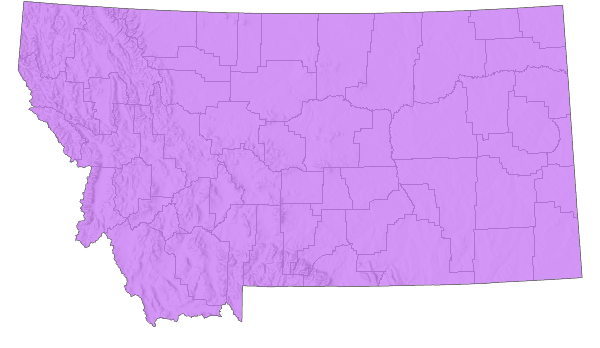
 Native
Native
Range Comments
This species ranges from the north in southeastern British Columbia, to southwestern Manitoba, and south to New Mexico and western Texas. From west to east, most of Washington, northeast Oregon, and Utah, across the Rocky Mountains, Great Plains to western Iowa, southwest Missouri, and northwest Arkansas. In Montana, it has been reported for 43 counties, but possibly occurs statewide (Otte 1984, Vickery and Kevan 1985, Pfadt 2002, Capinera et al. 2004, and Scott 2010).
Observations in Montana Natural Heritage Program Database
Number of Observations: 29
(Click on the following maps and charts to see full sized version)
Map Help and Descriptions
Relative Density
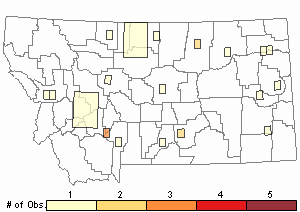
Recency
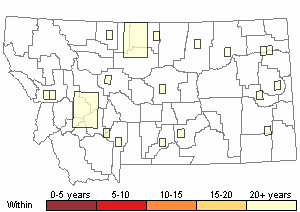

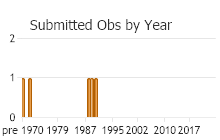
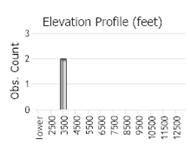 (Observations spanning multiple months or years are excluded from time charts)
(Observations spanning multiple months or years are excluded from time charts)
Habitat
The Say’s Grasshopper inhabits grasslands, tallgrass, shortgrass, and mixed grass prairies with patches of bare soil, but seems to favor sagebrush steppe and, especially, wheatgrass-bluegrass communities (Otte 1984, Vickery and Kevan 1985, Pfadt 2002).
Food Habits
This species feeds on a diversity of grasses, sedges, and forbs. Over its geographic range,
Blue Gramma (
Bouteloua gracilis), appears to be its preferred food. Other favored grasses and forbs include
Needle-and-Thread (
Stipa comata),
Prairie Sandreed (
Calamovilfa longifolia), and milkvetch,
Astragalus sp. (Capinera and Sechrist 1982, and Pfadt 2002).
Reproductive Characteristics
To date, no observations have been reported regarding courtship behavior. Females deposit their eggs into bare soil locations interspersed among grasses. Egg pods are large, measuring 28.6 to 31.7 mm long. The egg holding section inside measures 19 mm long by 4.8 mm in diameter and above the eggs 38 mm of the pod consists of a light brown froth. The pod contains 24-26 light brown eggs, 5 to 5.5 mm long. Nymphs pass through 5 instar stages before reaching the adult stage. The nymphal period is 49 to 64 days, with an average of 55 days (Pfadt 2002).
Stewardship Responsibility
References
- Literature Cited AboveLegend:
 View Online Publication
View Online Publication Brooks, A.R. 1958. Acridoidea of Southern Alberta, Saskatchewan, and Manitoba (Orthoptera). The Canadian Entomologist (Supplement 9) 90:5-92.
Brooks, A.R. 1958. Acridoidea of Southern Alberta, Saskatchewan, and Manitoba (Orthoptera). The Canadian Entomologist (Supplement 9) 90:5-92. Brust, M.L, W.W. Hoback, and R.J. Wright. 2008. The Grasshoppers of Nebraska. Lincoln, NB: University of Nebraska Extension Service, APHIS.
Brust, M.L, W.W. Hoback, and R.J. Wright. 2008. The Grasshoppers of Nebraska. Lincoln, NB: University of Nebraska Extension Service, APHIS. Capinera, J.L. and T.S. Sechrist. 1982. Grasshoppers of Colorado: Identification, Biology, and Management. Fort Collins, CO: Colorado State University Experiment Station, Bulletin 584S. 161 p.
Capinera, J.L. and T.S. Sechrist. 1982. Grasshoppers of Colorado: Identification, Biology, and Management. Fort Collins, CO: Colorado State University Experiment Station, Bulletin 584S. 161 p. Capinera, J.L., R.D. Scott, and T.J. Walker. 2004. Field Guide to Grasshoppers, Katydids, and Crickets of the United States. Ithaca, NY. Cornell University Press.
Capinera, J.L., R.D. Scott, and T.J. Walker. 2004. Field Guide to Grasshoppers, Katydids, and Crickets of the United States. Ithaca, NY. Cornell University Press. Hebard, M. 1928. The Orthoptera of Montana. Proceedings of the Academy of Natural Sciences of Philadelphia, Vol. 80:211-306.
Hebard, M. 1928. The Orthoptera of Montana. Proceedings of the Academy of Natural Sciences of Philadelphia, Vol. 80:211-306. Helfer, J.R. 1971. How to Know the Grasshoppers, Crickets, Cockroaches, and Their Allies. Revised edition (out of print), Mineola, NY: Dover Publications.
Helfer, J.R. 1971. How to Know the Grasshoppers, Crickets, Cockroaches, and Their Allies. Revised edition (out of print), Mineola, NY: Dover Publications. Otte, Daniel. 1970. A comparative study of communicative behavior in grasshoppers. Miscellaneous Publications, Museum of Zoology, No. 141. Ann Arbor, MI: University of Michigan.
Otte, Daniel. 1970. A comparative study of communicative behavior in grasshoppers. Miscellaneous Publications, Museum of Zoology, No. 141. Ann Arbor, MI: University of Michigan. Otte, Daniel. 1984. The North American Grasshoppers Volume II. Acrididae (Oedipodinae). Harvard University Press. 366 pp.
Otte, Daniel. 1984. The North American Grasshoppers Volume II. Acrididae (Oedipodinae). Harvard University Press. 366 pp. Pfadt, R.E. 2002. Field Guide to Common Western Grasshoppers, 3rd edition. Laramie, WY: Wyoming Agricultural Experiment Station, Bulletin 912, modified by S. Schell and S. Schell for electronic publication. Accessed 19 February 2020. http://www.uwyo.edu/entomology/grasshoppers/field-guide/index.html#fieldguidetoc
Pfadt, R.E. 2002. Field Guide to Common Western Grasshoppers, 3rd edition. Laramie, WY: Wyoming Agricultural Experiment Station, Bulletin 912, modified by S. Schell and S. Schell for electronic publication. Accessed 19 February 2020. http://www.uwyo.edu/entomology/grasshoppers/field-guide/index.html#fieldguidetoc Scott, R.D. 2010. Montana Grasshoppers, Katydids, and Crickets A Pictorial Field Guide to the Orthoptera. MagpieMTGraphics, Billings, MT.
Scott, R.D. 2010. Montana Grasshoppers, Katydids, and Crickets A Pictorial Field Guide to the Orthoptera. MagpieMTGraphics, Billings, MT. Vickery, V. R. and D. K. M. Kevan. 1985. The grasshopper, crickets, and related insects of Canada and adjacent regions. Biosystematics Research Institute, Ottawa, Ontario. Publication Number 1777. 918 pp.
Vickery, V. R. and D. K. M. Kevan. 1985. The grasshopper, crickets, and related insects of Canada and adjacent regions. Biosystematics Research Institute, Ottawa, Ontario. Publication Number 1777. 918 pp.
- Additional ReferencesLegend:
 View Online Publication
View Online Publication
Do you know of a citation we're missing? Anderson, N.L. 1951. Field studies on the biology of range grasshoppers of southeastern Montana. M.Sc. Thesis. Bozeman, Montana: Montana State University. 96 p.
Anderson, N.L. 1951. Field studies on the biology of range grasshoppers of southeastern Montana. M.Sc. Thesis. Bozeman, Montana: Montana State University. 96 p. Anderson, N.L. 1962. Grasshopper-vegetation relationships on Montana grasslands. Ph.D Dissertation. Bozeman, Montana: Montana State University. 73 p.
Anderson, N.L. 1962. Grasshopper-vegetation relationships on Montana grasslands. Ph.D Dissertation. Bozeman, Montana: Montana State University. 73 p. Gillespie, R.L.1992. Dynamics of grasshoppers (Orthoptera: Acrididae) at a rangeland-crop interference. Ph.D. Bozeman, MT: Montana State University. 111 p.
Gillespie, R.L.1992. Dynamics of grasshoppers (Orthoptera: Acrididae) at a rangeland-crop interference. Ph.D. Bozeman, MT: Montana State University. 111 p. Hebard, M. 1932. Notes on Montana Orthoptera. Proceedings of the Academy of Natural Sciences of Philadelphia. V. 84. pp 251-257.
Hebard, M. 1932. Notes on Montana Orthoptera. Proceedings of the Academy of Natural Sciences of Philadelphia. V. 84. pp 251-257. Larson, D.P. 1996. Evaluation of sweep sampling as a method for determining grasshopper community composition on rangeland. M.Sc. Thesis. Bozeman, MT: Montana State University. 92 p.
Larson, D.P. 1996. Evaluation of sweep sampling as a method for determining grasshopper community composition on rangeland. M.Sc. Thesis. Bozeman, MT: Montana State University. 92 p. McDaniel, B. 1987. Grasshoppers of South Dakota. Brookings, SD: South Dakota Agricultural Experiment Station, Bulletin TB 89.
McDaniel, B. 1987. Grasshoppers of South Dakota. Brookings, SD: South Dakota Agricultural Experiment Station, Bulletin TB 89. Mussgnug, G.L. 1972. The structure and performance of an adult population of Aulocara elliotti (Thomas) (Orthoptera, Acrididae) near Billings, Montana. M.Sc. Thesis. Bozeman, MT: Montana State University. 97 p.
Mussgnug, G.L. 1972. The structure and performance of an adult population of Aulocara elliotti (Thomas) (Orthoptera, Acrididae) near Billings, Montana. M.Sc. Thesis. Bozeman, MT: Montana State University. 97 p. Sater, S. 2022. The insects of Sevenmile Creek, a pictorial guide to their diversity and ecology. Undergraduate Thesis. Helena, MT: Carroll College. 242 p.
Sater, S. 2022. The insects of Sevenmile Creek, a pictorial guide to their diversity and ecology. Undergraduate Thesis. Helena, MT: Carroll College. 242 p. Skinner, K.F. 1995. Plant and grasshopper community composition: indicators & interactions across three spatial scales. M.Sc. Thesis. Bozeman, MT: Montana State University. 144 p.
Skinner, K.F. 1995. Plant and grasshopper community composition: indicators & interactions across three spatial scales. M.Sc. Thesis. Bozeman, MT: Montana State University. 144 p.
- Web Search Engines for Articles on "Say's Grasshopper"
- Additional Sources of Information Related to "Insects"





